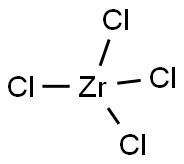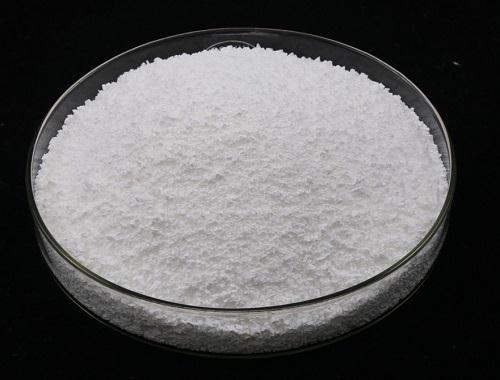
Циркония(IV) хлорид
- английское имяZirconium tetrachloride
- CAS №10026-11-6
- CBNumberCB8298375
- ФормулаCl4Zr
- мольный вес233.04
- EINECS233-058-2
- номер MDLMFCD00011306
- файл Mol10026-11-6.mol
| Температура плавления | 437 °C | ||||||||||||||
| Температура кипения | 331°C | ||||||||||||||
| плотность | 2.8 g/mL at 25 °C(lit.) | ||||||||||||||
| Плотность накопления | 1200kg/m3 | ||||||||||||||
| давление пара | 1 mm Hg ( 190 °C) | ||||||||||||||
| температура хранения | Store below +30°C. | ||||||||||||||
| растворимость | Soluble in alcohol, ether, hydrochloric acid. | ||||||||||||||
| форма | powder | ||||||||||||||
| цвет | White | ||||||||||||||
| Удельный вес | 2.803 | ||||||||||||||
| РН | <1 (H2O, 20℃)(saturated aqueous solution) | ||||||||||||||
| Растворимость в воде | Reacts with water. | ||||||||||||||
| Чувствительный | Moisture Sensitive & Hygroscopic | ||||||||||||||
| Гидролитическая чувствительность | 7: reacts slowly with moisture/water | ||||||||||||||
| Мерк | 14,10174 | ||||||||||||||
| crystal system | Monoclinic | ||||||||||||||
| Space group | P2/c | ||||||||||||||
| Lattice constant |
|
||||||||||||||
| Пределы воздействия | ACGIH: TWA 5 mg/m3; STEL 10 mg/m3 NIOSH: IDLH 25 mg/m3; TWA 5 mg/m3; STEL 10 mg/m3 |
||||||||||||||
| Справочник по базе данных CAS | 10026-11-6(CAS DataBase Reference) | ||||||||||||||
| Рейтинг продуктов питания EWG | 1 | ||||||||||||||
| FDA UNII | Z88176T871 | ||||||||||||||
| Справочник по химии NIST | Zirconium tetrachloride(10026-11-6) | ||||||||||||||
| Система регистрации веществ EPA | Zirconium tetrachloride (10026-11-6) | ||||||||||||||
| UNSPSC Code | 12352302 | ||||||||||||||
| NACRES | NA.23 |
| Коды опасности | C | |||||||||
| Заявления о рисках | 14-22-34-35 | |||||||||
| Заявления о безопасности | 26-36/37/39-45-8 | |||||||||
| РИДАДР | UN 2503 8/PG 3 | |||||||||
| WGK Германия | 3 | |||||||||
| RTECS | ZH7175000 | |||||||||
| F | 19 | |||||||||
| TSCA | Yes | |||||||||
| кода HS | 2827 39 85 | |||||||||
| Класс опасности | 8 | |||||||||
| Группа упаковки | III | |||||||||
| Банк данных об опасных веществах | 10026-11-6(Hazardous Substances Data) | |||||||||
| Токсичность | LD50 in mice, rats (mg/kg): 665, 1688 orally (Zhilova, Kasparov) | |||||||||
| NFPA 704: |
|
рисовальное письмо(GHS)
-
рисовальное письмо(GHS)

-
сигнальный язык
опасность
-
вредная бумага
H314:При попадании на кожу и в глаза вызывает химические ожоги.
H290:Может вызывать коррозию металлов.
-
оператор предупредительных мер
P234:Хранить только в оригинальной упаковке.
P260:Не вдыхать газ/ пары/ пыль/ аэрозоли/ дым/ туман.
P280:Использовать перчатки/ средства защиты глаз/ лица.
P301+P330+P331:ПРИ ПРОГЛАТЫВАНИИ: Прополоскать рот. Не вызывать рвоту!
P303+P361+P353:ПРИ ПОПАДАНИИ НА КОЖУ (или волосы): Снять/удалить немедленно всю загрязненную одежду. Промыть кожу водой.
P305+P351+P338:ПРИ ПОПАДАНИИ В ГЛАЗА: Осторожно промыть глаза водой в течение нескольких минут. Снять контактные линзы, если Вы ими пользуетесь и если это легко сделать. Продолжить промывание глаз.
Циркония(IV) хлорид химические свойства, назначение, производство
Химические свойства
White, lustrous crystals. Sublimes above 300C. Soluble in alcohol; decomposes in water.
Химические свойства
Zirconium tetrachloride forms lustrous, white, monoclinic crystals that melt at 437 ℃. It is a corrosive powder. It is hygroscopic, and thus soluble in cold water, alcohol, ether, and concentrated hydrochloric acid. It reacts vigorously with water forming hydrogen chloride (irritating vapor) and zirconium oxychloride. When moist, zirconium tetrachloride reacts with common materials to form hydrochloric acid that is corrosive to many metals. Through hydrolysis to HCl, zirconium tetrachloride can irritate the respiratory tract and other superficial surfaces of the body on exposure. Zirconium tetrachloride readily forms coordinate bonds with oxygen and nitrogen in organic molecules.Физические свойства
White monoclinic crystals; hygroscopic; density 2.80 g/cm3; sublimes at 331°C; triple point 437°C; vapor pressure 1 torr at 190°C; critical temperature 504.85°C; critical pressure 56.95 atm; critical volume 319 cm3/mol; decomposed by water; soluble in alcohol, ether, and concentrated hydrochloric acid.Использование
Zirconium tetrachloride is commonly utilized as a Lewis acid catalyst in many organic synthesis reactions. It is an important source for organometallic complexes of zirconium. It is practiced in many areas like nuclear industry, metal industry, photography, glass, and ceramic industry.Подготовка
Zirconium tetrachloride is obtained as an intermediate in recovering zirconium metal from zircon and other minerals (See Zirconium, Recovery). The tetrachloride is obtained by heating a mixture of zirconium hydroxide and car 1004 bon with chlorine gasAlso, tetrachloride can be made by reacting zirconium hydroxide with hydrochloric acid: Zr(OH)4 + 4HCl → ZrCl4 + 4H2O.
Определение
ChEBI: Zirconium tetrachloride is a zirconium coordination entity comprising four chlorine atoms bound to a central zirconium atom. It has a role as a catalyst. It is a zirconium coordination entity and an inorganic chloride.Общее описание
White lustrous crystalline solid. Used as a source of pure zirconium, as a tanning agent, in analytical chemistry and in treating textiles. Zirconium tetrachloride is decomposed by water. Corrosive to metals in the presence of moisture and to tissue.Реакции воздуха и воды
Reacts vigorously with water forming hydrochloric acid with the evolution of heat.Профиль реактивности
Zirconium tetrachloride is corrosive to metals in the presence of moisture and to tissue. Behavior in Fire: Will not burn - sublimes above 626°F (331°C). May give off HCl fumes [USCG, 1999]. Zirconium tetrachloride is incompatible with alcohols (ethanol), lithium metal, and tetrahydrofuran.Угроза здоровью
INHALATION: Irritating to upper respiratory tract; presumably caused by liberated HCl. EYES: Irritating. SKIN: Irritating. INGESTION: Burning pain in the mouth and throat, vomiting, watery or bloody diarrhea, retching, collapse, and convulsions.Пожароопасность
Behavior in Fire: Will not burn - sublimes above 626°F (331°C). May give off HCl fumes.Профиль безопасности
Moderately toxic by ingestion. A corrosive irritant to skin, eyes, and mucous membranes. Ignites spontaneously in air. When heated to decomposition it emits toxic fumes of Cl-. See also ZIRCONIUM COMPOUNDS and HYDROCHLORIC ACID.Методы очистки
Crystallise it repeatedly from conc HCl. It is hydrolysed by H2O to form white ZrOCl2 (see below) and HCl. [Krebs Z Anorg Allgem Chem 378 263 1970.]Циркония(IV) хлорид запасные части и сырье
Циркония(IV) хлорид поставщик
| поставщик | телефон | страна | номенклатура продукции | благоприятные условия | |
|---|---|---|---|---|---|
| 02120970332; +8613524231522 |
China | 2904 | 58 | ||
| +86-0510-83593312 +8619805123561 |
China | 67 | 58 | ||
| +8615531157085 | China | 8804 | 58 | ||
| +86 13288715578 +8613288715578 |
China | 12825 | 58 | ||
| +86-13131129325 | China | 5887 | 58 | ||
| +86-(0)57185586718 +86-13336195806 |
China | 29792 | 60 | ||
| +86-0371-55170693 +86-19937530512 |
China | 21632 | 55 | ||
| +86-0371-86658258 +8613203830695 |
China | 29871 | 58 | ||
| 18871490254 | CHINA | 28172 | 58 | ||
| 18631714998 | CHINA | 904 | 58 |